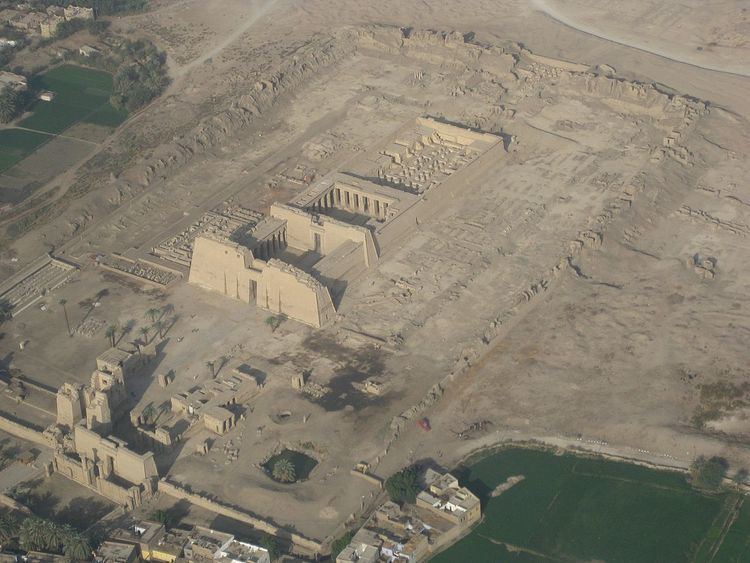Location Medinet Habu Excavation dates 1859 and 1899 | Type mortuary temple | |
 | ||
Address Al Bairat, Luxor, Luxor Governorate, Egypt Hours Closing soon · 6AM–5PMFriday6AM–5PMSaturday6AM–5PMSunday6AM–5PMMonday6AM–5PMTuesday6AM–5PMWednesday6AM–5PMThursday6AM–5PM Similar Colossi of Memnon, Ramesseum, Karnak, Luxor Temple, Deir el‑Bahari | ||
The Mortuary Temple of Ramesses III at Medinet Habu is an important New Kingdom period structure in the West Bank of Luxor in Egypt. Aside from its size and architectural and artistic importance, the temple is probably best known as the source of inscribed reliefs depicting the advent and defeat of the Sea Peoples during the reign of Ramesses III.
Contents
Modern identification and excavation
As for much of ancient Egypt, the first European to describe the temple in modern literature was Vivant Denon, who visited the temple in 1799-1801. Champollion described the temple in detail in 1829.
Initial excavation of the temple took place sporadically between 1859 and 1899, under the auspices of the Department of Antiquities. During these decades the main temple was cleared, and a large number of Coptic period buildings, including a substantial Coptic Church in the second court, were destroyed without notes or records being taken.
The further excavation, recording and conservation of the temple has been facilitated in chief part by the Architectural and Epigraphic Surveys of University of Chicago's Oriental Institute, almost continuously since 1924.
Description
The temple, some 150 m long, is of orthodox design, and resembles closely the nearby mortuary temple of Ramesses II (the Ramesseum). The temple precinct measures approximately 210 m (690 ft). by 300 m (1,000 ft) and contains more than 7,000 m2 (75,347 sq ft) of decorated wall reliefs. Its walls are relatively well preserved and it is surrounded by a massive mudbrick enclosure, which may have been fortified. The original entrance is through a fortified gate-house, known as a migdol (a common architectural feature of Asiatic fortresses of the time).
Just inside the enclosure, to the south, are chapels of Amenirdis I, Shepenupet II and Nitiqret, all of whom had the title of Divine Adoratrice of Amun.
The first pylon leads into an open courtyard, lined with colossal statues of Ramesses III as Osiris on one side, and uncarved columns on the other. The second pylon leads into a peristyle hall, again featuring columns in the shape of Ramesses. This leads up a ramp that leads (through a columned portico) to the third pylon and then into the large hypostyle hall (which has lost its roof). Reliefs and actual heads of foreign captives were also found placed within the temple perhaps in an attempt to symbolise the king's control over Syria and Nubia.
In Coptic times, there was a church inside the temple structure, which has since been removed. Some of the carvings in the main wall of the temple have been altered by coptic carvings.
The Royal Palace was directly connected with the first courtyard of the Temple via the "Window of Appearances".
Minor king list
The Medinet Habu king list is a procession celebrating the festival of Min, with the names of nine pharaohs. It can be found on the upper register of the eastern wall in the second courtyard.
